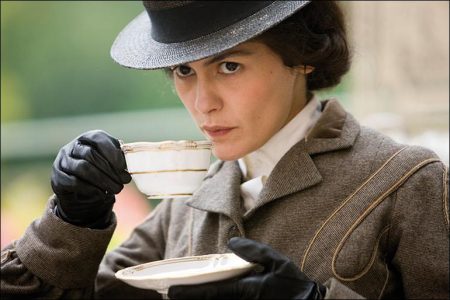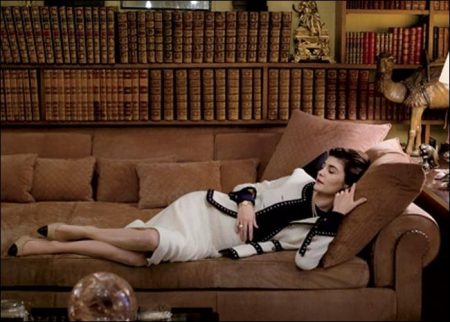Taglines: Before she was France’s famous mademoiselle…
Coco Before Chanel is the story of Gabrielle “Coco” Chanel, who began her life as headstrong orphan, and through an extraordinary journey became the legendary couturier who embodied the modern woman and became a timeless symbol of success, freedom and style. The film portrays the formative years of Chanel’s life, the years of Chanel spent discovering and inventing herself.
A little girl who is sent with her sister to an orphanage in the heart of France, who waits in vain every Sunday for her father to come for her.
A cabaret performer with a weak voice who sings to an audience of drunken soldiers.
A humble seamstress, who stitches hems at the back of a provincial tailor’s shop. A young, skinny courtesan, to whom protector Etienne Balsan offers a safe haven.
A woman in love who knows she will never be anyone?s wife, refusing marriage even to Boy Capel, the man who returned her love.
A rebel who finds the conventions of her time oppressive, and instead dresses in her lovers’ clothes.
This is the story of Gabrielle Chanel, who begins her life as a headstrong orphan, and through an extraordinary journey becomes the legendary couturier who embodied the modern woman and became a timeless symbol of success, freedom and style. Coco before she became Chanel.
Coco Before Chanel (French: Coco avant Chanel) is a 2009 French film about the early life of famed French fashion designer Coco Chanel. French actress Audrey Tautou stars as Chanel. Coco avant Chanel was directed and co-written by actor turned director Anne Fontaine. The film was first released in April 2009 in France.
As of 21 December that year, it had grossed $43,832,376 worldwide. The production budget was $23 million. Instead of releasing Coco Before Chanel in the United States itself, Warner Bros. Pictures let Sony Pictures Classics handle the release there. The film grossed $6 million in the United States. Coco Before Chanel was nominated for four BAFTA Awards, three European Film Awards, six César Awards and the Academy Award for Best Costume Design.
About the Production
Director Anne Fontaine has long been fascinated by the figure of Coco Chanel. “It was not so much the fashion as the characteristics of this exceptional woman that interested me,” says Fontaine. “I had been particularly touched by the fact that she was a self-made person. This girl, coming from the heart of the French countryside, poor, uneducated, but endowed with an exceptional personality, was destined to be ahead of her time.”
Years after her imagination was first sparked, the opportunity to make a film about the legendary woman presented itself. “I had to think whether it was possible to stick to the first period of her life-the training years, what had happened before Chanel, herself, understood her dazzling destiny,” the director explains. “So, I went back and read her biography by Edmonde Charles-Roux, Chanel and Her World: Friends, Fashion, and Fame. The other imperative condition was to find an actress to embody such a character, and not someone who would ape or make a pale imitation of Chanel.”
Fontaine found Chanel personified in Audrey Tautou. ”On my first encounter with Audrey, I was struck by her will, her audacity, and the density of her gaze that goes through you,” Fontaine recalls. “Chanel looked at everything. Her culture was not one of knowledge, but a culture of observation. I had not yet written a single line of the screenplay when I met Audrey, but I knew that if she gave me her trust and if the production agreed to stick to the years of apprenticeship, I could then embark on the adventure of my first period movie.”
Audrey Tautou as Gabrielle “Coco” Chanel
Tautou was likewise fascinated by Chanel, and though the prospect of the role had long been hovering around her, she was captivated by Fontaine’s vision. “I was secretly hoping to get an offer with a particular point of view because the modernity of this character-her spirit, and the position she gave women-fascinates me,” says Tautou. “In addition, when Anne Fontaine explained how she intended to treat the subject, I immediately agreed.”
“Anne has allowed me to develop the nature of Chanel by searching different aspects of this role, by shading the emotions, being fragile and sweet and, at the same time, commanding and proud,” the actress continues. “The fact that a woman directs this movie is already a great advantage to express how difficult it was to be of `the weaker sex’ at that time. The intelligence of Anne Fontaine, her finesse, her global vision of the character and the story have been of utmost importance in her direction of the film.”
To successfully complete this ambitious project and faithfully portray Coco Chanel’s formative years, Fontaine was determined to assemble accomplished and acclaimed creative department heads. “It was the first time I was doing a period movie, so I wanted to work with technicians who were experienced in their respective fields,” she says.
Fontaine worked at length beforehand with her key crew members and proposed a survey of various great films from the time period in which the story is set. “Some are still classics, others were made by talented directors but are now considered old fashioned,” says Fontaine, adding, “The historical film is a very tricky genre because it is easy to fall into the trap of flirting with the conventions of a TV movie. From the outset, we had to take a hard-line attitude against the weighty, picturesque drawbacks of the period film.”
Cinematography
Fontaine collaborated with Beaucarne to always reflect Chanel’s point of view in the cinematography. “The movie had to be like Coco Chanel’s character,” she explains. “She was a young woman who never stayed still. The filming had to pulsate and the camera required a certain sensuality and movement. We often used a hand-held camera to shoot. Christophe Beaucarne is a very physical, adaptable cameraman. The openness and integrity with which he approached this film helped me a lot.”
The moviemaker and her director of photography decided to shoot with two cameras to keep up the rhythm and pace and give the scenes a certain modernity. “The idea was to always accompany Chanel in her evolution and follow her inner adventure, her love story. The film is almost always shot from her viewpoint, except for two or three sequences linked to her feelings,” says Beaucarne, adding, “With Anne, we refused to resort to the complacency and contemplative side of period movies; there are no descriptive crane movements lingering on the grandeur of the set with its pageants of horse-drawn carriages and cohorts of extras! The luxury of the movie is precisely in not flaunting our resources. In the race course scene, for example, there are 300 extras on screen, but we have no protracted descriptive shots. The main thing was to portray the atmosphere at race courses in those days. They were packed because it was one of those places where you had to be seen.”
Beaucarne chose to shoot the scenes at Royallieu in sunlight to accentuate the château’s dazzling whiteness. “Although she was born in the country, Coco was shut up in the orphanage at a very early age,” Beaucarne describes. “She then lived in a maid’s garret and a smoky cabaret, and suddenly, in the château, she discovered the wonders of nature. I tried to transcribe, via the framing and lighting, the sense of liberation Chanel must have felt there. After the severity of Aubazine, where we used a lot of black and white, we wanted sunshine, wider frames and a festive atmosphere that corresponded to Balsan’s personality. For this bright and light-hearted side, with the set designer Olivier Radot, we had The Great Gatsby in mind as one of our distant references.”
Beaucarne also relished reinterpreting Cecil Beaton’s iconic photos of Chanel, “such as Chanel in her workshop, for example,” he says. “In the final sequence in the stairwell of the Maison CHANEL on rue Cambon, the lighting I devised plays with residual light to give an elliptical feel to the scene, where the fabulous models on the catwalk are seen as reflections in the mirrors only. What was important here was to suggest Chanel’s intimate vision.”
Beaucarne confesses he was inspired by the extremely photogenic quality of Audrey Tautou. “I played on the contrast between the lightness of her skin and the darkness of her eyes and hair,” he reflects. “Her eyes steal the show… I avoided putting direct lighting on her to emphasize a certain soft yet contrasted side, a subtle touch that also let me obtain the contours I wanted for the costumes and materials. Audrey identified keenly with her character, fully grasping Chanel’s strong, determined spirit. It was a real delight to film her, for in addition to her good looks, Audrey pays great attention to technique. Her variations of gesture and movement in her acting are extremely precise.”
The final element-the music-fell to Oscar-nominated composer Alexandre Desplat (The Curious Case of Benjamin Button, The Queen), who has written the soundtrack to more than 60 films. This gifted and prolific composer divides his time between French productions (Largo Winch, The Singer, The Valet), and international films. His inspired soundtrack for The Beat That My Heart Skipped won the César Best Music award in France and a Silver Bear at the Berlin International Film Festival.
Like the physical aspects of the production, Fontaine and Desplat collaborated to reflect Chanel herself in the music. ”I think Coco Chanel had a pair of eyes that were very particular in real life, and so does Audrey Tautou,” Desplat comments. “They both have the same gravity and intensity. She is not just watching. She’s scrutinizing and really intensively watching. She’s grabbing a detail, a colour, a shape that become something of her own once it goes through her filter. So, I guess that’s the main thing that I tried to do with the score: always keep the intensity of her character, not just the fun. She has a lot of courage and a desire to change things. And that’s something I like a lot-when artists show the way, a different way, another way, not just follow the flow of the river. My music should follow this.”
The final effect, Fontaine hopes, will be a complete interpretation of a young woman on the cusp of inventing herself. “What particularly interested me was to watch Coco build her destiny before our eyes, by inventing as she went along,” she says. “Nothing was programmed with her; she is not pursuing a career to reach success; she is inventing. She does not have the ambition or the tools to conform to the world of the bourgeoisie-its doors were closed to her-so she drew attention to herself to start at the top of provocation. She does not want to abide by this world but to adapt it to her own personality. She also likes to take risks. I liked very much the idea that she was a clandestine when she started her journey in the world. When she arrives to Royallieu, Balsan forbids her to leave her bedroom. She forged her emblematic image upon the secrets of her origins; she always embellished the story of her childhood.”
Continue Reading and View the Theatrical Trailer
Coco Before Chanel (2009)
Directed by: Anne Fontaine
Starring: Audrey Tautou, Alessandro Nivola, Marie Gillain, Benoît Poelvoorde, Emmanuelle Devos, Roch Leibovici, Etienne Bartholomeus, Fabien Béhar, Jean-Yves Chatelais, Lisa Cohen, Pierre Diot, Berenice Sand
Screenplay by: Anne Fontaine, Edmonde Charles-Roux
Production Design by: Olivier Radot
Cinematography by: Christophe Beaucarne
Film Editing by: Luc Barnier
Costume Design by: Catherine Leterrier
Set Decoration by: Nathalie Roubaud
Music by: Alexandre Desplat
MPAA Rating: PG-13 for sexual content and smoking.
Distributed by: Sony Pictures Classics
Release Date: September 25, 2009
Views: 156







